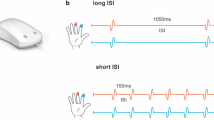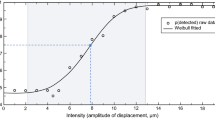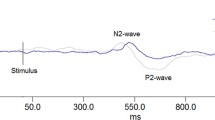Abstract
The goal of this study was to explore neural response to touch in children with and without autism spectrum disorder (ASD). Patterns of reduced (hypo-responsiveness) and enhanced (hyper-responsiveness) behavioral reaction to sensory input are prevalent in ASD, but their neural mechanisms are poorly understood. We measured event-related potentials (ERP) to a puff of air on the fingertip and collected parent report of tactile hypo- and hyper-responsiveness in children with ASD (n = 21, mean (SD) age 11.25 (3.09), 2 female), and an age-matched typically developing comparison group (n = 28, mean (SD) age 10.1 (3.08, 2 female). A global measure of ERP response strength approximately 220–270 ms post-stimulus was associated with tactile hypo-responsiveness in ASD, while tactile hyper-responsiveness was associated with earlier neural response (approximately 120–220 ms post-stimulus) in both groups. These neural responses also related to autism severity. These results suggest that, in ASD, tactile hypo- and hyper-responsiveness may reflect different waypoints in the neural processing stream of sensory input. The timing of the relationship for hyper-responsiveness is consistent with somatosensory association cortical response, while that for hypo-responsiveness is more consistent with later processes that may involve allocation of attention or emotional valence to the stimulus.



Similar content being viewed by others
References
Achenbach TM, Rescorla LA (2001) Manual for the ASEBA school age forms and profiles. University of Vermont, Burlington
Alexander AL, Lee JE, Lazar M, Boudos R, DuBray MB, Oakes TR et al (2007) Diffusion tensor imaging of the corpus callosum in Autism. NeuroImage 34(1):61–73. doi:10.1016/j.neuroimage.2006.08.032
Baranek GT, Berkson G (1994) Tactile defensiveness in children with developmental disabilities: responsiveness and habituation. J Autism Dev Disord 24(4):457–471
Cascio C, Styner M, Smith RG, Poe MD, Gerig G, Hazlett HC et al (2006) Reduced relationship to cortical white matter volume revealed by tractography-based segmentation of the corpus callosum in young children with developmental delay. Am J Psychiatry 163(12):2157–2163. doi:10.1176/appi.ajp.163.12.2157
Cascio C, McGlone F, Folger S, Tannan V, Baranek G, Pelphrey KA, Essick G (2008) Tactile perception in adults with autism: a multidimensional psychophysical study. J Autism Dev Disord 38:127–137
Cascio CJ, Foss-Feig JH, Burnette CP, Heacock JL, Cosby AA (2012) The rubber hand illusion in children with autism spectrum disorders: delayed influence of combined tactile and visual input on proprioception. Autism 16:406–419
Cascio CJ, Lorenzi J, Baranek GT (2013) Self-reported pleasantness ratings and examiner-coded defensiveness in response to touch in children with ASD: effects of stimulus material and bodily location. J Autism Dev Disord. doi:10.1007/s10803-013-1961-1
Coskun MA, Varghese L, Reddoch S, Castillo EM, Pearson DA, Loveland KA et l (2009) How somatic cortical maps differ in autistic and typical brains. Neuroreport 20(2):175–179. doi:10.1097/WNR.0b013e32831f47d1
Coskun MA, Loveland KA, Pearson DA, Papanicolaou AC, Sheth BR (2013) Interaction of finger representations in the cortex of individuals with autism: a functional window into cortical inhibition. Autism Res 6(6):542–549. doi:10.1002/aur.1314
Dunn W (1999) The Sensory Profile. The Psychological Corporation, San Antonio
Foss-Feig JH, Heacock J, Cascio CJ (2012) Tactile responsiveness patterns and their association with core features in autism spectrum disorders. Res Autism Spectr Disord 6:337–344
Gomot M, Wicker B (2012) A challenging, unpredictable world for people with autism spectrum disorder. Int J Psychophysiol 83(2):240–247. doi:10.1016/j.ijpsycho.2011.09.017
Gotham K, Pickles A, Lord C (2009) Standardizing ADOS scores for a measure of severity in autism spectrum disorders. J Autism Dev Disord 39(5):693–705. doi:10.1007/s10803-008-0674-3
Gratton G, Coles MG, Donchin E (1983) A new method for off-line removal of ocular artifact. Electroencephalogr Clin Neurophysiol 55(4):468–484
Green SA, Rudie JD, Colich NL, Wood JJ, Shirinyan D, Hernandez L et al (2013) Overreactive brain responses to sensory stimuli in youth with autism spectrum disorders. J Am Acad Child Adolesc Psychiatry 52(11):1158–1172. doi:10.1016/j.jaac.2013.08.004
Guthrie D, Buchwald JS (1991) Significance testing of difference potentials. Psychophysiology 28(2):240–244
Hardan AY, Pabalan M, Gupta N, Bansal R, Melhem NM, Fedorov S et al (2009) Corpus callosum volume in children with autism. Psychiatry Res 174(1):57–61. doi:10.1016/j.pscychresns.2009.03.005
Hashimoto I, Yoshikawa, K, and Sasaki, M. (1990). Latencies of peripheral nerve and cerebral evoked responses to air-puff and electrical stimuli. Muscle Nerve 13(12):1099–1104. doi:10.1002/mus.880131203
Kaufman AS, Kaufman NL (2004) KBIT2: Kaufman Brief Intelligence Test-II, 2nd edn. AGS Publishing, Circle Pines
Kekoni J, Hämäläinen H, McCloud V, Reinikainen K, Näätänen R (1996) Is the somatosensory N250 related to deviance discrimination or conscious target detection? Electroencephalogr Clin Neurophysiol 100(2):115–125
Khan S, Michmizos K, Tommerdahl M, Ganesan S, Kitzbichler MG, Zetino M et al (2015) Somatosensory cortex functional connectivity abnormalities in autism show opposite trends, depending on direction and spatial scale. Brain: A J Neurol 138(Pt 5):1394–1409. doi:10.1093/brain/awv043
Little LM, Freuler AC, Houser MB, Guckian L, Carbine K, David FJ, Baranek GT (2011) Psychometric validation of the Sensory Experiences Questionnaire. Am J Occup Ther 65:207–210
Lord C, Rutter M, Le Couteur A (1994) Autism Diagnostic Interview-Revised: a revised version of a diagnostic interview for caregivers of individuals with possible pervasive developmental disorders. J Autism Dev Disord 24(5):659–685
Lord C, Risi S, Lambrecht L, Cook EH, Leventhal BL, DiLavore PC et al (2000) The autism diagnostic observation schedule-generic: a standard measure of social and communication deficits associated with the spectrum of autism. J Autism Dev Disord, 30(3):205–223
Maitre NL, Barnett ZP, Key APF (2012) Novel assessment of cortical response to somatosensory stimuli in children with hemiparetic cerebral palsy. J Child Neurol 27(10):1276–1283. doi:10.1177/0883073811435682
Marco EJ, Khatibi K, Hill SS, Siegel B, Arroyo MS, Dowling AF et al (2012) Children with autism show reduced somatosensory response: an MEG study. Autism Res 5(5):340–351. doi:10.1002/aur.1247
Markram K, Markram H (2010) The intense world theory - a unifying theory of the neurobiology of autism. Front Human Neurosci 4:224. doi:10.3389/fnhum.2010.00224
Mima T, Nagamine T, Nakamura K, Shibasaki H (1998) Attention modulates both primary and second somatosensory cortical activities in humans: a magnetoencephalographic study. J Neurophysiol 80(4):2215–2221
Miyazaki M, Fujii E, Saijo T, Mori K, Hashimoto T, Kagami S, Kuroda Y (2007) Short-latency somatosensory evoked potentials in infantile autism: evidence of hyperactivity in the right primary somatosensory area. Dev Med Child Neurol 49(1):13–17. doi:10.1111/j.1469-8749.2007.0059a.x
Perrin F, Pernier J, Bertrand O, Echallier JF (1989) Spherical splines for scalp potential and current density mapping. Electroencephalogr Clin Neurophysiol 72(2):184–187
Pryweller JR, Schauder KB, Anderson AW, Heacock JL, Foss-Feig JH, Newsom CR et al (2014) White matter correlates of sensory processing in autism spectrum disorders. NeuroImage. Clin 6:379–387. doi:10.1016/j.nicl.2014.09.018
Puts NAJ, Wodka EL, Tommerdahl M, Mostofsky SH, Edden RAE (2014) Impaired tactile processing in children with autism spectrum disorder. J Neurophysiol 111(9):1803–1811. doi:10.1152/jn.00890.2013
Rutter M, Bailey AJ, Lord C (2003) The social communication questionnaire. Western Psychological Services, Los Angeles
Schauder KB, Muller CL, Veenstra-VanderWeele J, Cascio CJ (2015) Genetic variation in serotonin transporter modulates tactile hyperresponsiveness in ASD. Res Autism Spectr Disord 10:93–100. doi:10.1016/j.rasd.2014.11.008
Silva LMT Schalock M, Gabrielsen KR, Budden SS, Buenrostro M, Horton G (2015) Early intervention with a parent-delivered massage protocol directed at tactile abnormalities decreases severity of autism and improves child-to-parent interactions: a replication study. Autism Res Treat 2015 904585. 10.1155/2015/904585
Skrandies W (1990) Global field power and topographic similarity. Brain Topogr 3(1):137–141
Sörös P, Knecht S, Imai T, Gürtler S, Lütkenhöner B, Ringelstein EB, Henningsen H (1999) Cortical asymmetries of the human somatosensory hand representation in right- and left-handers. Neurosci Lett 271(2):89–92
Tavassoli T, Auyeung B, Murphy LC, Baron-Cohen S, Chakrabarti B (2012) Variation in the autism candidate gene GABRB3 modulates tactile sensitivity in typically developing children. Mol. Autism, 3(1):6. doi:10.1186/2040-2392-3-6
Tommerdahl M, Tannan V, Cascio CJ, Baranek GT, Whitsel BL (2007) Vibrotactile adaptation fails to enhance spatial localization in adults with autism. Brain Res 1154:116–123
Voos AC, Pelphrey KA, Kaiser MD (2013) Autistic traits are associated with diminished neural response to affective touch. Soc Cognitive Affect Neurosci 8(4):378–386. doi:10.1093/scan/nss009
Watson LR, Patten E, Baranek GT, Poe M Boyd BA, Freuler A, Lorenzi J (2011) Differential associations between sensory response patterns and language, social, and communication measures in children with autism or other developmental disabilities. J Speech Lang Hearing Res 54(6):1562–1576. doi:10.1044/1092-4388(2011/10-0029)
Wechsler D (1999) WASI: Wechsler Abbreviated Scale of Intelligence. Harcourt Assessment Inc, San
Zopf R, Giabbiconi CM, Gruber T, Müller MM (2004) Attentional modulation of the human somatosensory evoked potential in a trial-by-trial spatial cueing and sustained spatial attention task measured with high density 128 channels EEG. Cognitive Brain Res 20(3):491–509. doi:10.1016/j.cogbrainres.2004.04.006
Acknowledgments
This work was supported by the National Institutes of Health (K01 MH090232 awarded to C.J.C., UL1 TR000445 from NCATS/NIH, and P30 HD015052). Effort for C.J.C. is also supported by R01 MH102272. The authors wish to thank Dorita Jones of the Vanderbilt Kennedy Center Psychophysiology Laboratory for performing data processing, Jennifer Foss-Feig for assistance with a pilot version of the study, and Nathalie Maitre, M.D., PhD for supplying the puffer stimulator and protocol. The Cartool software (brainmapping.unige.ch/cartool) has been programmed by Denis Brunet, from the Functional Brain Mapping Laboratory, Geneva, Switzerland, and is supported by the Center for Biomedical Imaging (CIBM) of Geneva and Lausanne.
Author information
Authors and Affiliations
Corresponding author
Rights and permissions
About this article
Cite this article
Cascio, C.J., Gu, C., Schauder, K.B. et al. Somatosensory Event-Related Potentials and Association with Tactile Behavioral Responsiveness Patterns in Children with ASD. Brain Topogr 28, 895–903 (2015). https://doi.org/10.1007/s10548-015-0439-1
Received:
Accepted:
Published:
Issue Date:
DOI: https://doi.org/10.1007/s10548-015-0439-1




